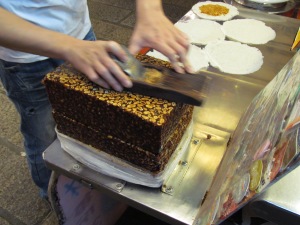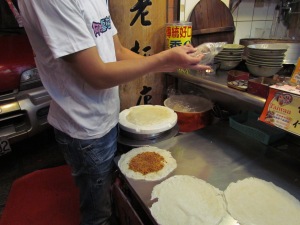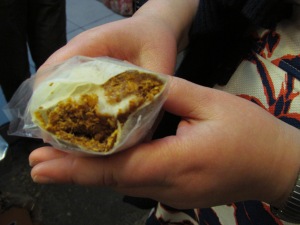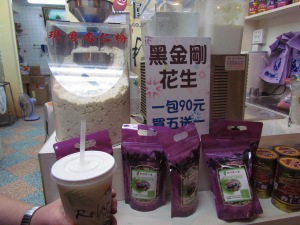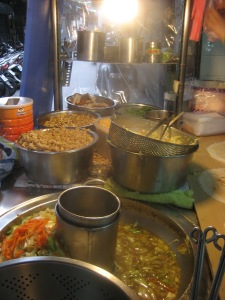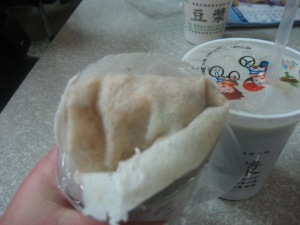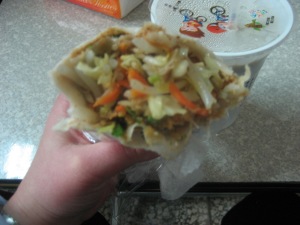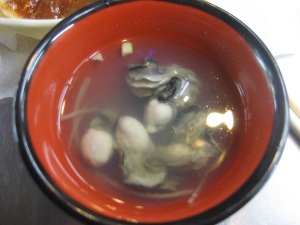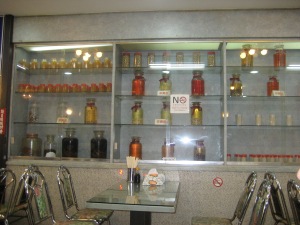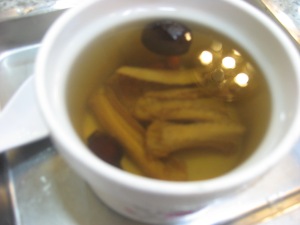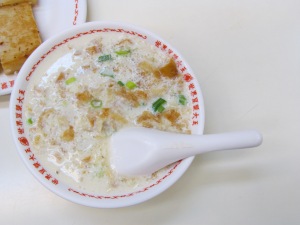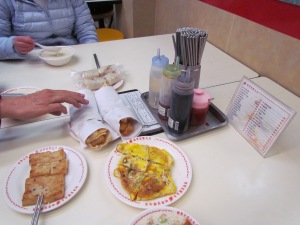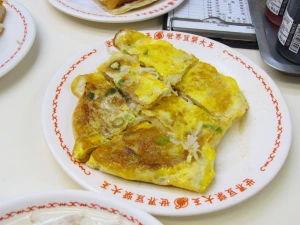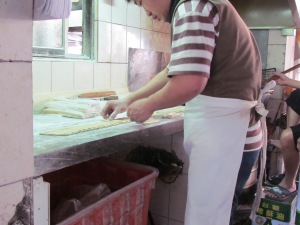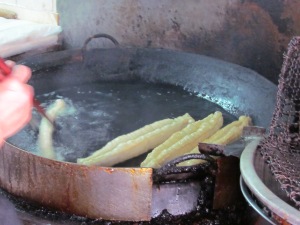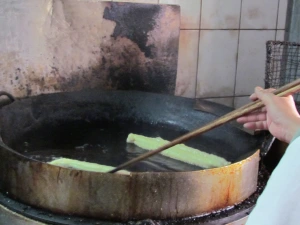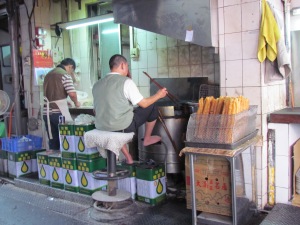My eating trip began with a very traditional dessert, peanut soup, in the food court at Eslite Xinyi, a huge bookstore/department store chain with some branches open 24 hours. (Imagine if Borders and Bloomingdale’s mated and the baby stayed up all night.) The one on the left is a warm version, and the one on the right is served over ice with doufu hua (literally, tofu flower), a very soft, sweet dessert tofu.

While in Taipei, I ate other desserts familiar to anyone who has been in Chinatown.
Red bean soup, the usual post-prandial sweet.

A deep fried glutinous rice and red bean thing rolled in sesame.

A variety of puddings and jellos, coconut being my favorite.

Coconut jello

Almond jello with the usual canned fruit cocktail

Mango pudding
Some of the desserts I had were not particularly traditional in the sense that they did not exist in the Taiwan of my parents and grandparents, but they have become part of the Taiwanese vernacular.
It’s strawberry season in Taiwan, and everywhere I went, markets had fresh strawberries. The Mister Donut chain was running a promotion of strawberry doughnuts. Pon are their standard ring doughnuts, which look like a bracelet of doughnut holes.

I bit these open so that I could photograph the insides. The one on the bottom is plain glazed, the pink one on top is strawberry.
The company’s mascots, led by the charming Pon de Lion, are among the most adorable corporate characters anywhere, though the Taiwan Life Insurance hippo gives them a good run for their money. (http://www.a-lung.com.tw/)


The doughnuts in Asia are different—much lighter in the belly and of course with flavors like matcha and red bean. (McDonald’s sometimes has fried pies with red bean and pineapple in addition to the usual apple pie.) Someone even told me that Dunkin’ Donuts products have half the sugar in Taiwan because the American versions are too sweet.
Crepes, both savory and sweet, are very popular in Taiwan. I felt that it wasn’t Taiwanese enough for me to try, but my cousins insisted, so I chose green tea and red bean, which is about as Asian as one can get. The crepe (top right) itself tasted exactly like a fortune cookie. (The other food in the picture will be explained in a later post.)

My family’s house is next to Café Mélange, the trendiest waffle restaurant in Taipei. They don’t take reservations, you have to take a number and wait, so all evening long, there are hip young Taiwanese lining our street waiting for a table. It sort of killed me that there was all this amazing Taiwanese street food about 100 steps away not to mention Mister Donut about 100 steps in the opposite direction but all these people were waiting an hour for Belgian waffles. This isn’t a passing fad, though. Apparently this place has been popular for years. I wonder what they would think of the glories of Waffle House, one of my American guilty pleasures. (While in Florida, I once went four times in a 24-hour span.)

One Taiwanese sweet that is known almost globally is bubble tea (or milk tea to me, since I always get it without the tapioca pearls—small round things, you know.) Though I decry the extra plastic bag they give to protect your hand from the condensation, it’s admittedly convenient to dangle your bubble tea from your wrist while noshing on your skewers of fried squid and chicken.
People in Taiwan are very particular about bubble tea. Despite plenty of stands in Shida Night Market proper, my cousin insisted that we walk five blocks outside to her preferred shop. If you get annoyed by people ordering a grande soy mocha half-caf skim latte with walking room is picky, you’ll definitely be bothered by regular orders for such specifics as 70% sugar, 50% ice bubble tea!
I’m not a very adventurous bubble tea drinker. Because I read Chinese too slowly to look at all the choices, my go-to flavors are almond and coconut, which appear on all menus. On this trip, I ventured into strawberry milk and pudding milk territories, but I think I’ll stick with almond and coconut. The strawberry was fresh but otherwise unmemorable, and the pudding was inadequately sweet—although it was streaked with chocolate, it wasn’t chocolaty enough (a common problem with Asian “chocolate” desserts—it’s not chocolate, it’s just brown) and the pulled through the thick straw, the pudding was the consistency of snot. I didn’t even think of trying the milk tea with “frog eggs” (mixed bubbles, cubes of lemon and grass jelly)!
 More to come about celebratory desserts in a future post.
More to come about celebratory desserts in a future post.
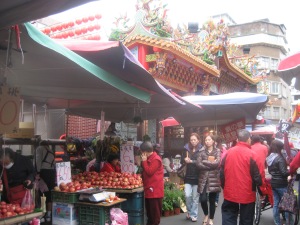 The stand was at a market near my family’s house. Despite Taiwan’s modernity and availability of European-style groceries, to say nothing of 24-hour convenience stores (more about these in a future post), many people still do their daily food shopping at markets like these, often outside temples. These open-air markets sell everything from produce, fish, meat, and flowers to kitchenware and underwear.
The stand was at a market near my family’s house. Despite Taiwan’s modernity and availability of European-style groceries, to say nothing of 24-hour convenience stores (more about these in a future post), many people still do their daily food shopping at markets like these, often outside temples. These open-air markets sell everything from produce, fish, meat, and flowers to kitchenware and underwear.